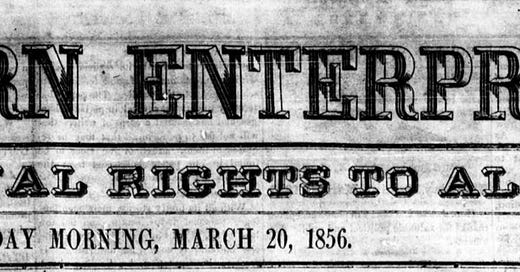1856: "An Ordinance For the Government of Slaves and Free Persons of Color."
America lumbered toward liberty.
“Be it further ordained, That no person shall let or hire to any slave any lot, house, room or building within the the town of Greenville..." — Sec. 3, Greenville, S.C.’s "An Ordinance For the government of Slaves and Free Persons of color."
In the mid-1800s, the US wasn't trending toward emancipation for Black Americans. The fiery rhetoric of abolitionists and liberty lovers certainly called for it, but the American Slavocracy would not let go. The Slave Power enacted new laws that limited all Americans' liberty simply so that wealthy southerners could perpetuate human bondage for personal profit.
Even as abolitionists and emancipators began to secure small wins against slavery in the court of law, corrupt legislatures and legislators quickly enacted new regulations on Americans in a perverse attempt to retain power. These laws not only limited the speech and association of enslaved and free Black Americans or free persons of color but white ones, too.
These restrictions came as late as 1856 in places like Greenville, South Carolina, which enacted "An Ordinance For the government of Slaves and Free Persons of color." It instituted a curfew, limited when and where enslaved Black Americans could congregate, and with whom they could associate.
But the ordinance went further than that.
The ordinance also restricted the movements of any person of color, free or enslaved. It limited what property they could own, what goods they could buy, and where they could work. The restrictions placed on persons of color also restricted the liberty of white Americans.
Sec. 3 of the ordinance states, "Be it further ordained, That no person shall let or hire to any slave any lot, house, room or building within the the town of Greenville." The ordinance is free of any qualifier.
Liberty for whom?
Liberty for All?
No.
In Cassius M. Clay's autobiography, he writes that a decade earlier, Lincoln County, Kentucky's Slavocracy in Stanford "had passed resolutions threatening with death the discussion of the slavery questions … I at once made an appointment to speak in Stanford. This, silly people thought, was useless bravado."
Clay insists in the book that he had to speak in the city because it'd put the slave-power:
"…in a fatal position; that if I spoke with safety, their policy of intimidation was broken forever; and the boldest of them feared the result, in a commonwealth where so small a portion of the voters were slave-holders, if I was put to death in the exercise of admitted constitutional rights." p. 76
The perversion of the idea of Liberty is often forgotten. Blatant constitutional violations, of which Clay and others suffered, were justified and enacted with the sole purpose of protecting slavery at all costs, and it forced all Americans to pay a hefty price.
Greenville printed its new ordinance in The Southern Enterprise, sandwiched between ads for "dry goods, groceries, hardware, &c." and a novel. Check out the full ordinance below.
PDF via The Library of Congress
Help Spread the Word!
If you’re new to this newsletter, why not subscribe? Enjoy articles like this and many more for free!
If you enjoyed this newsletter, please help others find this amazing content. Thank you!





